|
The mermite sleeves would be
filled with the meal and the area around the sleeves
would be filled with hot water (to help keep the food
warm) and then loaded on trucks or jeeps from the
unit, and "pushed" forward to the units. With
the mermites would go coffee, bread, little boxes of
ultra pasteurized white and chocolate milk, plastic
flatware, paper plates, condiments, etc. Once
arriving at the unit, soldiers would cycle back a few at
a time to the truck and pick up their meal. A
typical breakfast would be:
Dinner:
-
spaghetti or
chili mac
-
green beans
-
salad
An interesting
occurrence would take place when it took too long for the
breakfast ration to get forward. After a certain
amount of time the scrambled eggs would react with the
aluminum sleeves causing them to turn greenish in
color. So, you could literally have "green eggs
and ham".
The "chow truck"
would also bring forward cases of MCIs (Meal, Combat,
Individual) - the successor to the "C" Ration. You
would draw your lunch MCI when you got your breakfast.
More on the MCI below. The unit supply rooms also
kept a three day supply of MCIs on hand as "war rations"
to be used to feed the unit in the event of conflict.
When possible, they
would try to get mermites of hot coffee and hot soup
forward late during the night. During 24 hour
operations in a German winter, this was really nice.
*Note: I am
actually the proud owner of two fully functional
mermites that I inherited from my dad. One day I
plan to get some old army comrades together and have an
"old soldiers" dinner. We will serve it outside,
on a cold day, in the rain. The chow will arrive
on the back of a pickup, in the dark. We'll serve
"tactically" (five meters between each person in line,
in case we take incoming) using flashlights with red
filters. It'll SUCK but it'll be GREAT! I'm
thinking the chili mac meal above.
The most dreaded
ration cycle was C-C-C . . . . an MCI for breakfast, lunch and dinner. MREs
had not come out during the time I was in 2/11. A
detailed breakdown of MCIs is located
here. When you could heat them, they were
ok - cold, they could really wear you down. I will
always remember "Spaghetti with Meat Chunks". When
you opened it cold there would be about a half inch of
congealed grease on the top you could pry off.
I was lucky - My M577
had a very good diesel fired "pot-belly" stove that we
operated when the tent extension was set up. This
allowed my crew to heat rations on the top as well as
hot water for coffee, shaving, etc. This made all
the difference in the world during extended field
problems.
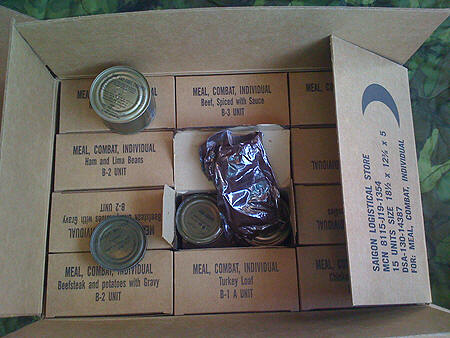
MCIs came 12 to a
case. You'd turn the box over so the meal
name was not visible to the soldier picking a
box. This made it "fair" for everybody
when getting your box. |
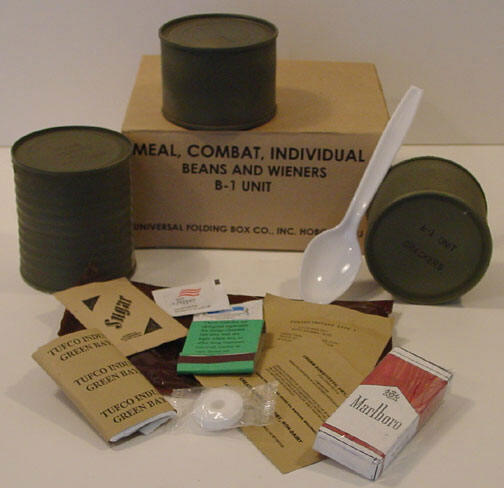
Early versions
of the MCI actually came with a little 6 pack of
cigarettes along with the meal. Also
included were toilet paper, matches, salt,
sugar, instant coffee, gum, etc. |
Update: A
friend from Facebook (with no military experience) read
this page and said," Those don't look like "pop-top"
cans - what did you do for a can opener?" A very
good point and something I completely overlooked.
The MCI cans were opened with an ingenious device
developed during World War 2 . The tool in
question is the P38 - a small can opener that was
provided in each case of MCIs. For the complete
story of the P38,
go here. Over time and with use, the color
of the P38 would go from silver to steel grey or black.
During the time I was
in 2/11 we were still issued the old GI "mess-kit". I
don't recall having ever used mine while in the unit.
The basic problem was making sure that they were
sterilized after each use. NOTHING takes a soldier
out of action faster than a case of food poisoning from
an improperly cleaned kit. The cleaning process in
the field for mess-kits consisted of a series of four
metal trash cans. The first one was where leftover
food was dumped and the kit scraped out. The next
three trash cans had gas-fired heaters in them.
the first one had detergent in it. You dipped your
kit in and brushed it out. The second one was a
"first rinse" and the third one was a "final rinse".
This process was time consuming to set up for mobile
units. This system was used back in the field
trains locations
to clean utensils from the MKTs. We always used
paper plates and plastic utensils that were simply
thrown away after use - thus eliminating the cleaning
problem.
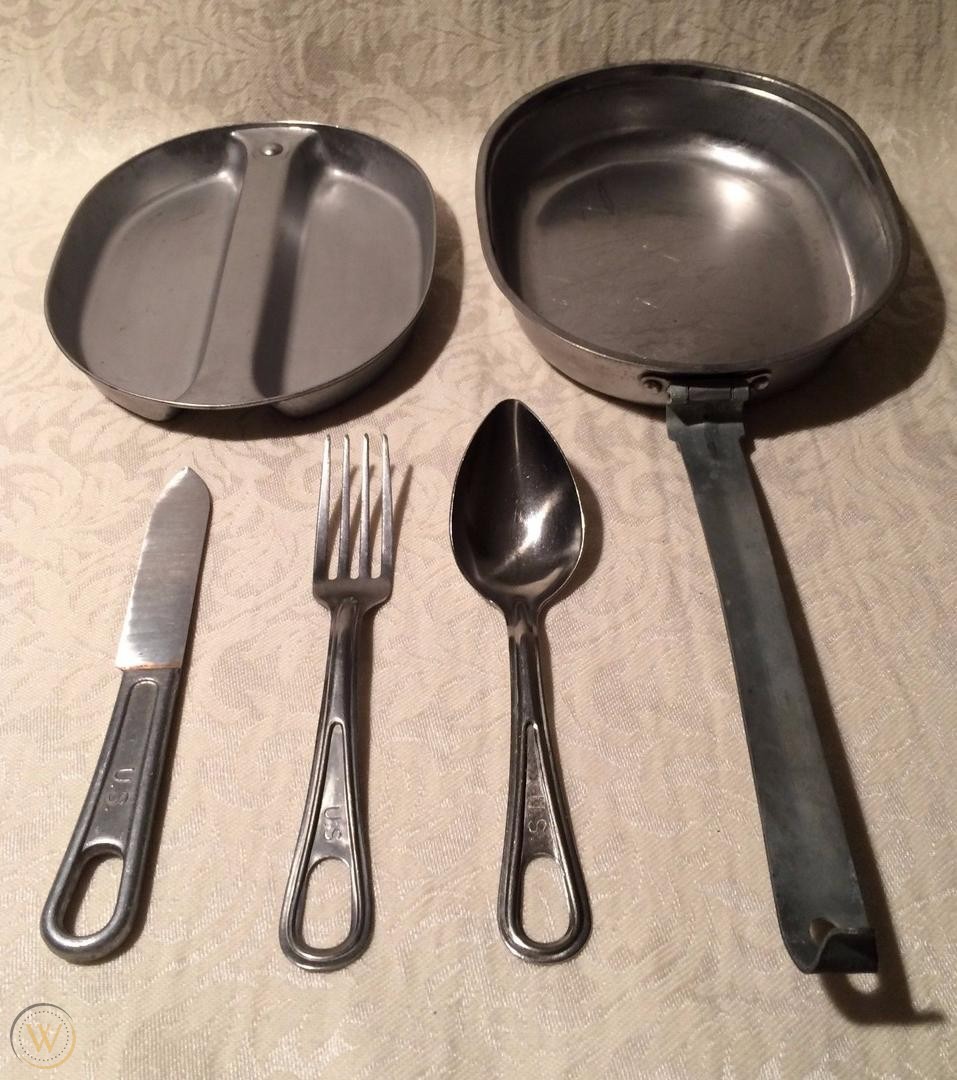
GI "Mess
Kit"
|
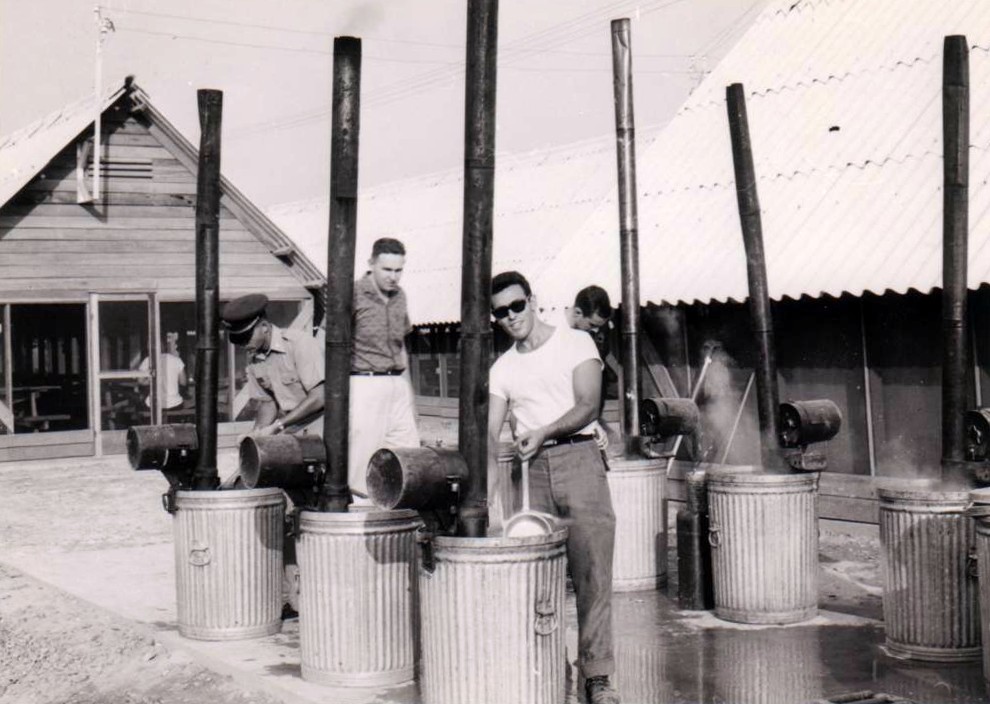
Mess kit cleaning
heaters
|
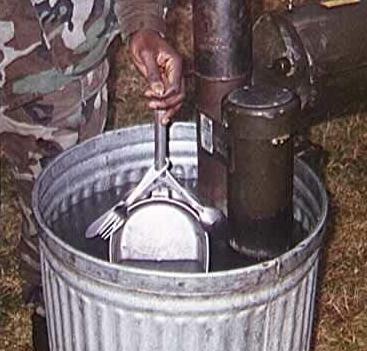
Mess kit being
cleaned - this appears to be the 3rd can which
just had hot water for the final rinse.
Notice the cutlery around the hand of the "big"
pan. The top, divided, portion of the kit
had a metal ring that allowed it to be placed
over the handle as well. |
Of course, there was
always "pogey bait", slang for non-army issue foodstuffs
taken to the field (even though this practice was
generally frowned on by the chain of command).
This was everything from cans of soda to ramen noodles .
. . anything to add a little variety to field rations.
During extended field
problems (REFORGER, etc) we would sometimes be able to
go to a local German town and buy some from the local
stores, bakeries, and butcher shops. I remember
REFORGER 81 during a break on the weekend we got most of
the battery rotated to the local town. We
descended like a swarm of locusts . . leaving the
shelves at the bakery and "metzgerei" virtually bare.
The owners were very happy but the local customers, not
so much . . .
Lastly - the
universal Army condiment in the field - TABASCO.
There was always a bottle (or bottles) to be found in
every vehicle. My NCO (when I was the fire
direction officer in the howitzer battery) actually had
it as part of the vehicle load plan that was posted in
the SOP. He had a small box to secure the bottle
that was in the space between two FM radios on the upper
shelf of the vehicle.
The Army sanctified this practice
with the advent of MREs into the system. The MRE
accessory packet would come with a miniature bottle of
actual Tabasco provided by the McIlhenny company - this
was probably the best addition ever made to the "C"
ration. I actually came back from Desert Storm
with over 1000 small bottles of Tabasco that I collected
while there. I don't know why . . . . .
|
|
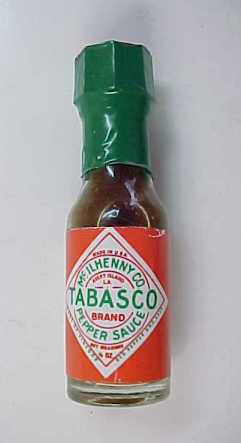
Tabasco - HOOAH! |
|